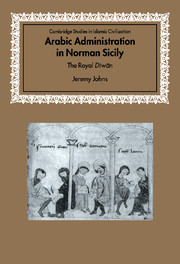Book contents
- Frontmatter
- Contents
- Preface
- Tables
- Abbreviations
- Genealogical table of the De Hautevilles of Sicily
- Note on Measurements
- Introduction
- 1 ‘In the time of the Saracens …’
- 2 ‘When first the Normans crossed into Sicily …’
- 3 ‘Our lady, the Regent Adelaide, and our Lord, the Count Roger, her son’, 1101–30
- 4 The earliest products of the royal dīwān, 1130–43
- 5 The jarāʾid renewed, 1144–5
- 6 The records of the royal dīwān. Part I: the jarāʾid al-rijāl
- 7 The records of the royal dīwān. Part II: the dafātir al-ḥudūd
- 8 The duties and organisation of the royal dīwān, 1141–94
- 9 ‘The people of his state’. The ‘palace Saracens’ and the royal dīwān
- 10 The Norman dīwān and Fāṭimid Egypt
- 11 Royal dīwān and royal image
- Appendix 1 Catalogue of dīwānī documents
- Appendix 2 Provisional catalogue of private documents
- Appendix 3 Abū Tillīs – ‘Old Wheat-sack’
- List of References
- Index
- Titles in the series
Introduction
Published online by Cambridge University Press: 10 March 2010
- Frontmatter
- Contents
- Preface
- Tables
- Abbreviations
- Genealogical table of the De Hautevilles of Sicily
- Note on Measurements
- Introduction
- 1 ‘In the time of the Saracens …’
- 2 ‘When first the Normans crossed into Sicily …’
- 3 ‘Our lady, the Regent Adelaide, and our Lord, the Count Roger, her son’, 1101–30
- 4 The earliest products of the royal dīwān, 1130–43
- 5 The jarāʾid renewed, 1144–5
- 6 The records of the royal dīwān. Part I: the jarāʾid al-rijāl
- 7 The records of the royal dīwān. Part II: the dafātir al-ḥudūd
- 8 The duties and organisation of the royal dīwān, 1141–94
- 9 ‘The people of his state’. The ‘palace Saracens’ and the royal dīwān
- 10 The Norman dīwān and Fāṭimid Egypt
- 11 Royal dīwān and royal image
- Appendix 1 Catalogue of dīwānī documents
- Appendix 2 Provisional catalogue of private documents
- Appendix 3 Abū Tillīs – ‘Old Wheat-sack’
- List of References
- Index
- Titles in the series
Summary
This book is written with a particular audience in mind, and seeks to introduce western medievalists, who have been trained to observe Norman kingship through predominantly Latin eyes and in the environment of north-western Europe, to what may for many be a new and disturbingly unfamiliar perspective. I have therefore chosen to set out from a much frequented point of departure, and to progress at a leisurely pace towards the Mediterranean. But, should historians of medieval Islam happen to open this book, they will find the administrative culture that it describes so familiar that they may well wonder that anyone should think so peripheral a subject worthy of such detailed attention. The following paragraphs are therefore also intended to introduce them to one of the western medieval historiographical questions underlying this book: the nature – indeed, the very existence – of what, whether it is observed in Normandy, England, Sicily or Antioch, may be recognized as an administrative policy peculiar to Norman rule.
In 1969, David C. Douglas stated the case as follows:
Before the twelfth century was far advanced, monarchies established by the Normans controlled the best organized kingdoms of Europe, and a Norman prince ruled the strongest of the Crusading states. This success was however not due merely to the facts of conquest or even to the establishment of notable rulers supported by strong feudal aristocracies. It derived also from a particular administrative policy which was everywhere adopted by the Normans. In all the states they governed, the Normans at this time were concerned to give fresh vitality to the administrative institutions which they found in the conquered lands, and to develop these constructively to their own advantage.
- Type
- Chapter
- Information
- Arabic Administration in Norman SicilyThe Royal Diwan, pp. 1 - 10Publisher: Cambridge University PressPrint publication year: 2002
- 1
- Cited by

